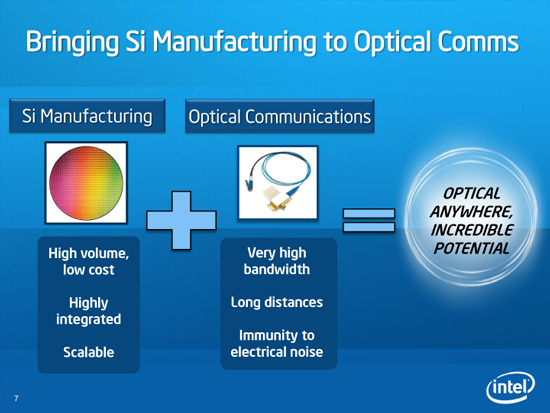Intel's 50Gbps Silicon Photonics Link: The Future of Interfaces
by Brian Klug on July 30, 2010 6:49 AM EST- Posted in
- Trade Shows
- Intel
- Photonics
- Laser
Why use light instead of copper?
High speed PCB design is already a science in and of itself. Timing requirements dictate equal path lengths for a growing number traces between components, resulting in the ever familiar squiggly designs on desktop motherboards. Higher frequencies of course also require considerations about wave propagation through the medium - just like a transmission line. At 1 GHz, for example, one wavelength is about 0.14 meters for copper traces on FR-4, one of the most common PCB materials.

There’s also propagation delay - for wires, commonly given as 1 ns for every 6 inches of length, though different media have different wave propagation speeds due to the dielectric of the medium. I could go on about the challenges of very high frequency circuit design - which I’m not an expert in by any stretch of the mind.
The end takeaway is that traditional microelectronic designs are becoming physically constrained in size with higher and higher frequencies. You physically need to have the CPU close to the memory controller, northbridge, and other components for it to work at frequencies people expect. Move it relatively far (one wavelength) away, and the design challenges start to stretch microelectronics to its limit. Ultimately, designs sacrifice speed for distance, or vice versa.
The advantages of using optical interconnects instead of traditional copper traces are numerous. Using light instead of copper promises vastly higher bandwidth, reduced latency, resistance to electromagnetic interference, and potentially even power savings.

All of these reasons make using optical, silicon waveguides instead of copper traces an obvious choice. Instead of using numerous copper traces to connect the CPU to the northbridge, for example, one could envision using a single optical fiber. Or having many CPUs on one massive board connect to a chipset located even meters of path distance away. Or even have one room full of just CPUs and another room full of memory.
What Intel demonstrated on Tuesday is a working example of just that - an optical interconnect fabricated using the current traditional CMOS process, for connecting conventional electronics. Effectively an optical bus on silicon.
What’s different about Intel’s demonstration is that the lasers themselves are hybrid silicon.










42 Comments
View All Comments
GullLars - Wednesday, August 4, 2010 - link
Go liquid cooling, and you can get 500-2000W worth of power as densely packed as an ITX card. By using optical connections to build in 3D, you can have multiple planes of components.nafhan - Friday, July 30, 2010 - link
Another problem with motherboard design that this will help with is RF interferance.nafhan - Friday, July 30, 2010 - link
For anyone with a radio background, if the term WDM seems odd it's the term used by fiber optic people for FDM.Also, like to emphasize how big of an advantage that photonics/fiber optics have over normal electrical signals in motherboard design or any other application with a high frequency electrical signal. Replacing electrical signals with something that has essentially no radiated signal is huge. No interference is a very good thing.
This stuff is just cool...
spunlex - Friday, July 30, 2010 - link
<quote> it emits primarily phonons (lattice vibrations - and through a ton of hand waving and thermodynamic processes, heat), and very few electrons. </quote>I think this should read "and very few <b>photons</b>."
Great article, it's good to see manufacturing of cheap quality lazers really took of in the past couple year. I am looking forward to many more interesting articles on photonics.
spunlex - Friday, July 30, 2010 - link
I totally forgot these comments don't support formating, still pining for the edit feature.Brian Klug - Friday, July 30, 2010 - link
Oh wow good catch! That's what I get for writing this so late at night!-Brian
spunlex - Friday, July 30, 2010 - link
I know what you mean, no where near as bad as some of the late night lab reports I have handed in.iwodo - Friday, July 30, 2010 - link
It mean we finally have VERY Good On broad Audio Chipset,GDILord - Monday, August 2, 2010 - link
Well, what exactly do broads have right now? :-)cesthree - Saturday, July 31, 2010 - link
When can we get this for an external GPU case?Have a case that only houses GPU's with their own PSU's and cooling solutions.
Connect that case with your case via a Photon Link. I can't begin to list the advantages of a setup like this.
I'm sure there is disadvantages. I know I would buy/make one if I could.